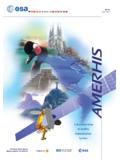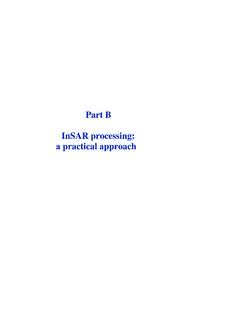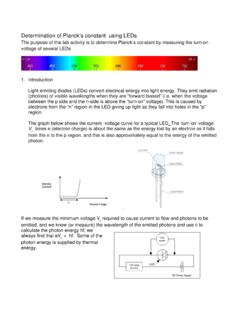Transcription of Concepts for wireless energy transmission via laser
1 Concepts for wireless energy transmission via laserLeopold Summerer, Oisin PurcellESA - Advanced Concepts TeamKeplerlaan 1, NL-2201AZ Noordwijk, The +31-71-565-6227 The present paper intends to link several disciplines in an attempt to describe an application ofoptical systems slightly out of their mainstream applications. Back in the middle age, optics, then the science of light has been fundamental in understanding our universe and changing our perspectiveof our place in it. Optics in form of laser communication and the use quantum encryption are enteringthe field of space telecommunication and might well reveal to be the single most enabling technologyfor the introduction of secure and high bandwidth communication.
2 In the present paper a differentapplication of optical links is discussed, using laser links not only as a communications channel butalso as a means to transfer energy without wires. Different Concepts and applications of wirelesspower transmission via laser are discussed, including terrestrial and space-based INTRODUCTIONW hile the science of light and vision has alwaysfascinated and influenced humans, the beginning ofmodern optics might be traced back to the famous Book of Optics by Ibn al-Haytham , which for thefirst time describes the theory of vision and light asa ray theory, unifying geometrical optics with philo-sophical physics.
3 His book already described experi-ments with lenses, mirrors, refraction, and scientific optics, with the invention of thetelescope in the 17thcentury by Dutch and Italianastronomers and mathematicians revolutionised ourway of viewing the universe and the place of Earthand thus ultimately our own place within is already one of the most cross disciplinarydisciplines, spanning from physics, chemistry, mathe-matics, electrical engineering up to architecture, psy-chology and medicine. This paper intends to describethe application of optics and light in an area where itis traditionally only marginally present: energy wireless energy TRANSMISSIONThe first attempts to transmit energy wirelesslywith the purpose of doing so are attributed to at his laboratory in Long Island, New Yorkjust 30 years after J.
4 Maxwell had predicted in 1873the transport of energy trough vacuum via electro-magnetic waves, validated in principle 15 years laterby H. Hertz . [1] Ibn al-Haytham, 965-1040; also known under the names ofAlhacenorAlhazen Nikola Tesla, 1856-1943 James Maxwell, 1831-1879 Heinrich Hertz, 1857-1894 Following the invention of the magnetron and theklystron in the 1920 and 1930, the developments dur-ing the second world war made microwave beamsavailable to a wider scientific community. The firstsuccessful engineering approach to use microwaves foreffective energy transmission was done by W. Brown in the 1960s, by powering among other devices a teth-ered helicopter.
5 [2]The first power stations in Earth orbit, taking ad-vantage of the absence of day-night cycles to harvestthe energy of the sun were described by the earlyspace pioneers K. Tsiokovski and H. Oberth . Pe-ter Glaser is recognised as the first to combine thevisions of these early space pioneers with the practi-cal advances in transmitting energy without wires byW. Brown in his 1968 publication in Science, whichcontained the first engineering description of a solarpower satellite (SPS). [3] It established a vision of asustainable, practically non-depletable and abundantsource of energy to meet world energy demands andtriggered the imagination of researchers around this pioneering article, several small andlarger scale studies and experiments have been per-formed around the world in order to mature the con-cept of solar power satellites further.
6 For a descrip-tion of how the concept had evolved since the 1968publication, it is referred to [4]. While these stud-ies and experiments were generally intensified duringtimes of high carbon fuel prices and received lowerattention during times of low oil and gas prices, theidea was never considered mature enough to be puton a larger industrial scale, but the general conceptof abundant, virtually CO2emission free power gen-erated in orbit and transmitted to where needed on William Brown, 1916-1999 Konstantin Tsiolkovski, 1957-1935 Hermann Oberth, 1894-1989 Earth has most of the time been considered as tooattractive to not pursue further.
7 The most compre-hensive study was done during 1979, when the USDoE and NASA made a joint technical analysis (fre-quently quoted as SPS reference study ) on the op-tions of SPS. [5]Furthermore, all studied so far essentially con-cluded that there were no principal technical show-stoppers to the concept. On the other hand, witheach redesign cycle based on new technology, the to-tal mass in orbit, cost and complexity of the entiresystem decreased substantially, indicating a remain-ing potential for further improvements. [5] [6] [7] [8]The most daring Concepts was probably proposedby Criswell et 1990: The proposed lunarpower stations would be very large installations onthe moon, generating energy from solar irradiationon the moon to transmit it to Earth, passing via re-lay stations and reflectors in Earth orbit.
8 [9] [10]Following the theoretical works in the 1950s andthe first presentation of a functioning laser in 1960,the use of lasers as a means to transmit energy be-came apparent. [11] [12] At the same time, the firstphotovoltaic cells were mounted on spacecraft to com-plement the energy provided by batteries to extendthe spacecraft operational much higher maturity level of microwave de-vices and the resulting order of magnitude higheroverall efficiency has however prevented the con-cepts of wireless energy transmission by laser to en-ter into the mainstream SPS Concepts for most ofthe last 30 years.
9 Recent exceptions include the pa-pers of Brandhorst, Steinsiek, Cougnet, Fork, andLuce. [13] [14] [15] [16]The present paper argues that advances in lasertechnology and operational as well as engineering ad-vantages of Concepts based on laser power transmis-sion provide ground for further interest in this con-cept and a stronger involvement of the scientific paper concentrates on technologies for long-distance wireless power transmission and medium range wireless power transmission ( via induction or evanescent wave coupling) arenot considered. [17]3. wireless energy TRANSMISSIONTECHNOLOGIESIn general, effective wireless energy transmissionconcepts need to comply with a range of fundamentalconstraints: possibility to transfer the energy though an at-mosphere ; transparency of the atmosphere tothe used wavelength; possibility for directional emission; possibility to convert the energy from the formof its source (solar, electric, heat) to a transmit-table form ( microwave, laser , accoustic); possibility to convert the transmittable energyform back into a useful form of energy ( elec-tricity, hydrogen).
10 While this paper concentrates on laser energytransmission, it is useful to compare its performancesand parameters with microwave energy transmission ,the most widely studied wireless energy transmissiontechnology. In principle, laser energy transmissionsystems are very similar to energy transmission viamicrowave technology: the power source (solar, elec-tricity) is converted into an emitter or an emitter ar-ray that generates the directional electromagnetic ra-diation, which is subsequently absorbed in a receiver,which transforms the energy back into a more useful,transportable form, electricity, heat, key difference, the wavelengths used, im-plies the major other differences between the laserand microwave-based Concepts .







